
Ethiopia: Bahar Dar and Lake Tana Monasteries
We arrived in Bahar Dar after a relatively smooth flight from Addis Ababa. When we arrived at the airport, which was under construction, a friendly guy named Addis (easy to remember!) from NGG Hotel was waiting for us. In actual fact, I think he was a tour agent who was somehow associated with the hotel, but nevertheless, Addis spoke excellent English and told us all sorts of interesting facts about Ethiopia and Bahar Dar. He explained that the Bahar Dar airport was under construction because the Bahar Dar area was increasingly exporting fresh cut flowers to the world via Dubai and thus more and more cargo flights were arriving and departing each week.
The main tourist attraction of Bahar Dar that we wanted to see were the monasteries of Lake Tana. Neither Sara nor I had done much research on the boat trips to the monasteries, but we quickly received a sales pitch from Addis about the tours while as we were driven from the airport to our hotel. I had read that tours could be booked for 150-200 birr, but Addis was pitching 300 birr including a breakfast at our hotel, transfer to the boat dock, and fast boat. He also told us that one of the monasteries would cost 100 birr to enter and that Sara would not be able to enter one of the monasteries as it was off limits to women.
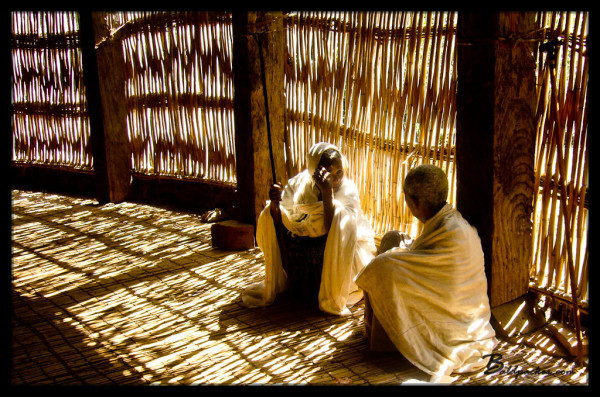
Ura Kidane Mehret Monastery Allows Women Inside
After hearing the sales pitch, Sara and I checked in to our room, which was great value for the 230 birr (US$ 11.50) per night that we paid and discussed our options. We decided that even though the trip was more expensive than what we could probably find elsewhere, Addis was very friendly, informative, and spoke excellent English, so it was worth the extra cost of going with him and not having to go haggle with another tour agent. After unpacking our luggage we went back to the lobby and agreed with Addis to meet him in the morning for the Lake Tana Monastery Tour.
Sara was eager to get out and explore Bahar Dar that night, so we set out in search of a restaurant for dinner. I had traveled a lot of Africa before our trip to Ethiopia and have always been very cautious about my safety at night. I set out with Sara having that same cautious mindset and was very concerned about being out at night in an unfamiliar town. I only mention this because my concern was completely unwarranted. Obviously, you should always be careful when you travel, but I soon learned that Ethiopia is the safest country in Africa and that people are generally very helpful and friendly. Despite the prevalent poverty, theft is relatively rare and violent crime is uncommon. I do not want people to read this and forget about safety all together, but in my opinion it is perfectly okay to walk the streets of Bahar Dar at night, whereas I would not say the same for similarly sized cities in South Africa, Kenya, or even parts of the United States or Canada.
After wandering a bit of Bahar Dar and realizing that sightseeing would be much better in the daylight, we found a restaurant with a balcony and tables that overlooked a busy street. Thinking it was a great way to both enjoy our first Ethiopian dinner and do some people watching, we found our way to a table where we were presented with an English menu. Although the menu said beer was available, upon request I was told they did not have any. One thing about Ethiopia is that menus will often have dozens of options, but only a few of them will be available at any given time. In this case, rather than beer, the server recommended I try a local Ethiopian red wine. Along with my wine (which, ironically, was served in a beer bottle), I ordered Lamb Tibs (grilled meat) and Sara ordered Shiro (powdered chickpea stew with minced onion and garlic), a vegan food that is very popular during Lent, Ramadan, and other fasting seasons.
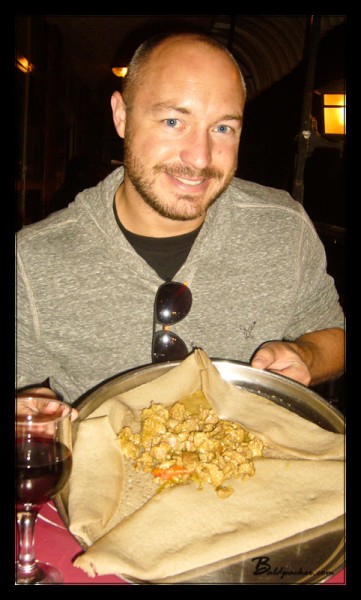
Lamb Tibs and Injera

Wine in a Beer Bottle!
Both of our meals were delicious but we also realized we had a lot to learn about ordering Ethiopian food. Ethiopian meals are definitely meant to be shared and I imagine we looked silly having both ordered our own dish as the servings are HUGE! Most Ethiopian cuisine is served with injera, a slightly sour flatbread with a spongy texture, which is used for scooping up the meats or stews that you order. Injera is traditionally made from the flour of teff, an annual grass native to the Horn of Africa that is both very rich in iron and gluten free, making it a very healthy grain. Although injera may not appeal to everyone, I thought it made for a wonderful sponge to soak up all of the delicious sauces and meat gravies that are usually part of Ethiopian main dishes, despite its slight sourness and strange texture.
After our meal we explored Bahar Dar a little more before deciding it was probably wise to get some sleep in preparation for our Lake Tana boating adventure the next day. As promised by Addis, the next morning he was there to meet us, get us breakfast, and organize our trip to the boat dock. He piled us into a tuk-tuk and took us to the dock where we were directed into a boat with a large number of other tourists. Unfortunately, Addis did not get on the boat with us, and we soon realized that all our “tour” included was a boat driver who did not speak English and was simply there to transport us from boat dock to boat dock. When we arrived at the first boat dock we had no idea where we had to walk to find the monastery so as a group we made an educated guess, followed a trail through the vegetation, and eventually came across a rather basic building built of sticks which apparently was a monastery. At that point, we were told that it would cost 100 birr (US$ 5) to enter what was essentially a stick fort! Based on what Addis had told us, I was expecting to have to pay 100 birr to enter Ura Kidane Mehret, but apparently all of the monasteries now charge a 100 birr admission fee.
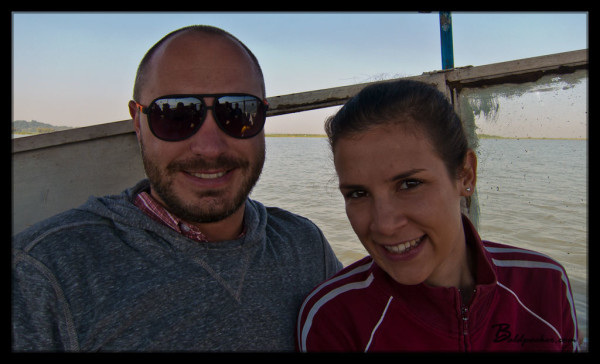
All Smiles…Since We Had Not Yet Realized Our “Tour” Was a Rip-Off!
No one from our tour group deemed the monastery worthy of the admission fee so we just walked around the outside, watched monkeys play in the trees, and looked at the coffee and fruit plants in the area before walking back to the boat. Of course, without any form of guide or leader our group became separated along the way and we lost one person somewhere in the brush. The boat driver did not even know how many people were supposed to be on our boat and was preparing to leave before someone noticed that an older Dutch fellow was missing. By this time I think our whole group was aware that our “tour” was not at all as advertised, so we all began comparing what we had been told the tour would include as well as what we paid. In the end, it sounds like everyone paid between 200-300 birr, with those on the cheaper end not receiving transportation or breakfast. A common theme throughout Ethiopia is that services / tours / schedules etc. will not be as advertised or promised, so no matter how many questions you ask or how many assurances you are given, always expect things to be a little different (worse) than expected and do your best to make the most of it.
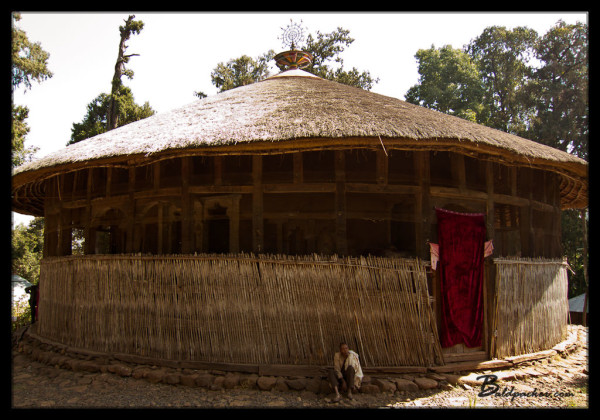
The First Monastery of Our “Tour” (No one knew the name…)
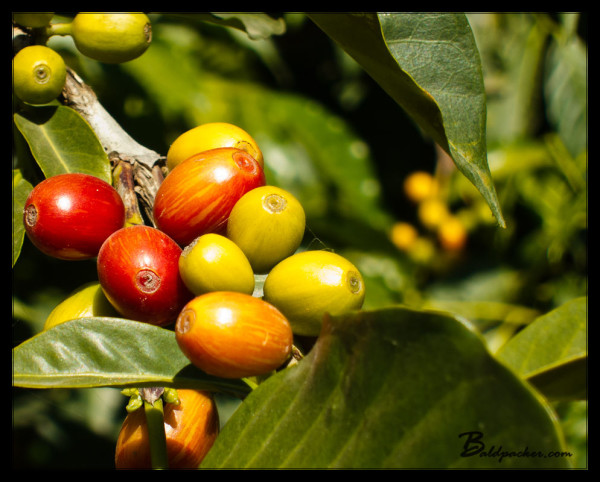
Coffee Beans Growing
The next stop on our “tour” was Ura Kidane Mehret, the most impressive monastery of the bunch. It was clear that Ura Kidane Mehret is also one of the more touristic monasteries on Lake Tana, as the path through the forest was lined with vendors selling handicrafts, crosses, paintings, scarves, and faux-artifacts. Everyone decided to pay the 100 birr admission fee to enter Ura Kidane Mehret, and it was well worth it. The Ura Kidane Mehret monastery is part of the Convent of Mercy (Ethiopian Orthodox Church) and it is located on the Zege peninsula. The convent was founded in the 14th century but the current structure is from the 16th century. The highlight of Ura Kidane Mehret for me were the murals, which had been painted 100-250 years ago and commonly depicted brutal violence.
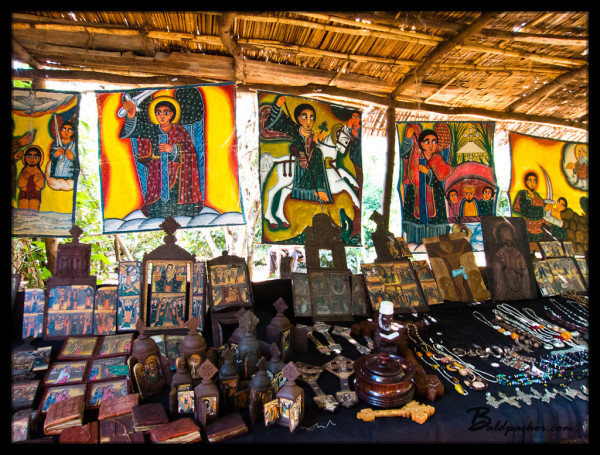
The Tourist Gauntlet to Ura Kidane Mehret
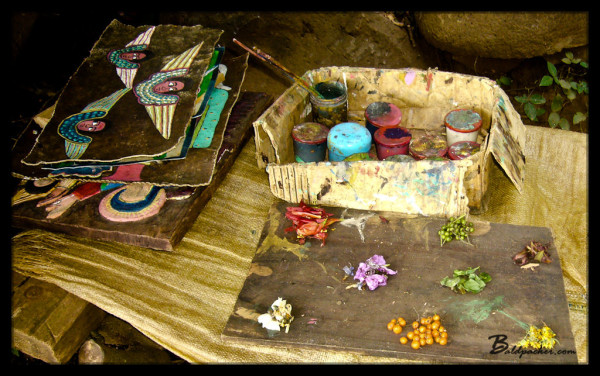
Sellers Claim their Paintings are Painted with Natural Inks
After the group had its fill of the paintings and artwork in Ura Kidane Mehret, we walked back to the boat where we were taken to the third and final monastery. By now it was already past noon (when we were told the tour would end) and everyone was getting hungry, tired, and a bit frustrated with the lack of explanation given on our “tour”. To make things even wors, the winds picked up and some people began feeling sea sick as our boat rocked from side to side while traversing the massive lake. At the third and final monastery, only a handful of people paid the 100 birr admission to go inside and the rest of us just hung out on the water’s edge, visiting and learning about each other’s travel plans. For the majority of us, money was not the reason we refused to pay the 100 birr admission fee, but rather the principle of it. ‘Principle’ became a very common theme for me in Ethiopia, and I would often refuse to do certain things, no matter how inexpensive, because ‘in principle’ I refuse to be ripped off by people asking extortionate rates from tourists. I recognize that in most poor countries there is a small “tourist tax” added on to prices and I usually have no problem paying it, but when the “tourist tax” becomes several times the local price, I refuse to pay based on my belief that if enough other tourists do the same, the “tourist tax” will be reduced to a reasonable level where everyone wins.
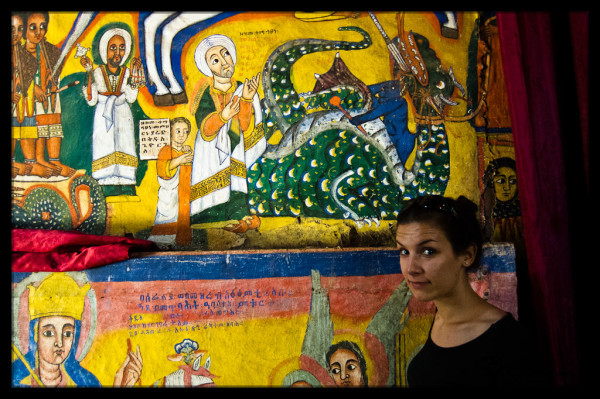
Sara Inside Ura Kidane Mehret
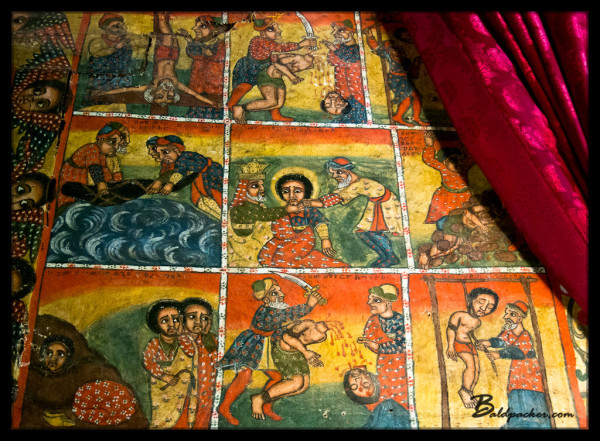
Violent Paintings Everywhere!

Eerie Lighting in the Monastery
After the third and final monastery we were back in our very slow boat to motor back to Bahar Dar. By now it was 2pm, much later than we had been told we would arrive back, but we still did one last side-trip to look for hippos. Of course, there were no hippos to be seen and I suspect the promise of hippo sightseeing is nothing more than an advertising gimmick for the Lake Tana monastery tours.
When we finally arrived back to Bahar Dar we were all starving and, given it was Christmas Day, six of us decided to go for a Christmas lunch together. A Mexican / Spanish couple said the food was great at their accommodation, which also had a large courtyard, so we went there for our Christmas feast. Sara and I had learned our lesson from the previous night and ordered one meal to share, a “fasting food” with injera. Fasting food is often on menus in Ethiopia and it simply means that it is a vegetarian dish. In this case, we were treated with 6 or 7 incredibly flavourful vegetable mixes to scoop up with the injera. My favourite was a spicy lentil mix which I later found is a very common Ethiopian dish usually served with fasting food. I also tried my first Dashen beer, a relatively flavourful pale lager. It was one of the best tasting commercial beers I have had in a developing country and given it was Christmas lunch, I decided to treat myself to two!
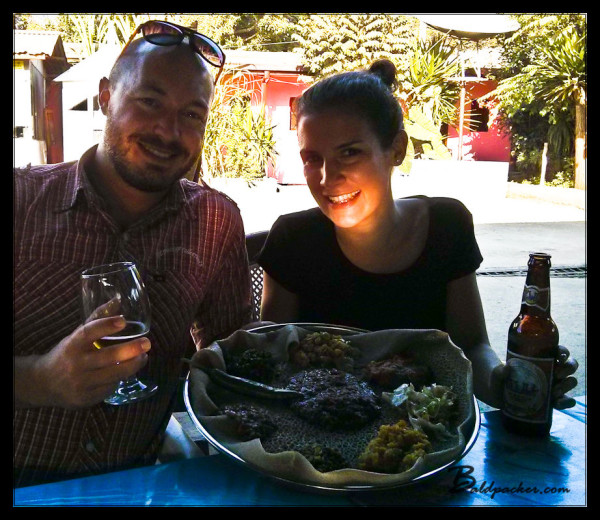
Christmas Lunch in Ethiopia!
After our late lunch the sun was beginning to set so Sara and I headed towards the Lake Tana hotel where it was apparently a good place to watch sunsets. We arrived a little late to see the sun set, but it it was still beautiful to sit and have a beer while watching beautiful colours streak the sky. Unfortunately, after the sun was down, the bugs came out in full force and we decided it was time we wander back to the hotel. When we arrived to the NGG Hotel lobby, we saw several people from our monastery tour and they invited us to join them for an evening of cultural dancing in town.
Ethiopian dancing is fantastic. Most Ethiopians have the ability to quickly vibrate their shoulders without moving their arms, which is amazing to see in person. I tried and tried throughout the trip to master this dance skill, but it is definitely more difficult than it looks. The cultural performance was partly comedy and even though I could not understand any Amharic, the crowd loved the performance and the laughter filled the building making me smile and laugh as well. As the dance performance went on, the performers grabbed a few of the foreigners to drag on stage and dance with. There was a tall Swedish guy who managed to show of his Ethiopiian shoulder dance pretty well, but it appeared he was in Ethiopia adopting an Ethiopian child, so he likely had plenty of practice prior to this performance. Jorge, a very funny guy from our group, was also selected and he put on his own comedy routine for the audience which helped take the suffering off of watching his Ethiopian dance skills.

Dancer Getting His Shoulder Shake On
Since we had an early morning mini bus ride to Gondar the next day, we left the performance relatively early, but both Sara and I greatly enjoyed our first ‘cultural dance’ experience in Ethiopia.
